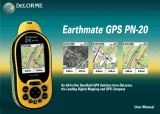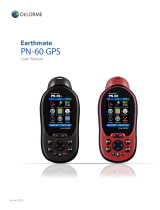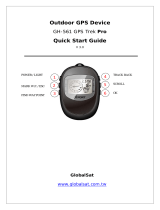
2
Getting Started
Thank you for purchasing the DeLorme Earthmate PN-40. This versatile and compact GPS receiver lets
you create tracks of your travels, create routes so you never get lost, nd points of interest, and more!
This manual provides instructions for using all of the functionality available on the Earthmate PN-40.
Most of the chapters are based on pages, which are the main screens on the Earthmate PN-40.
Each chapter describes the features of that particular page and the menu options that are available
from that page. In addition, this manual also discusses basic functions (such as map panning,
battery information, map data information, and more), as well as frequently asked questions,
warranty information, and so on.
Step 1 — Installing the Batteries
The Earthmate PN-40 is a battery-powered device. It can be powered by one rechargeable Lithium-
ion (Li-ion) battery or two AA batteries (NiMH, alkaline, or lithium).
To install the batteries, unscrew the D-rings on the back of the Earthmate PN-40 until you can
remove the battery cover. Then, insert the batteries according to the polarity symbols found inside
the battery compartment. Position the battery cover on the Earthmate PN-40 and screw the
D-rings into the Earthmate PN-40.
Step 2 — Turning On the Earthmate PN-40
The Power button is located at the bottom right corner of the button area. To turn on the Earthmate
PN-40, press and hold the Power button until you see the Welcome screen. The rst page that
appears on the screen after you turn on the Earthmate PN-40 is the Satellites Page. Your GPS
status displays in the top left corner of the Satellites Page. If you press the PAGE button, the Map
Page displays on the screen. The map will not center on your current location until you have achieved
a 2-D or 3-D x. The default view when a GPS x cannot be obtained is your last GPS position.
If it is taking a long time for the device to obtain a 2-D or 3-D x, verify it has a clear view of the
sky. Be sure that trees, buildings, and other obstacles are not blocking the Earthmate PN-40. If the
device still cannot obtain a 2-D or 3-D x, press the QUIT button to return to the Satellites Page,
press the MENU button, highlight the Set Current Location option, and then press ENTER. The
Map Page automatically displays. Pan the map to your current location and press ENTER.
Tips:
•Settingthecorrectbattery
typewilloptimizethebat-
tery’sperformance.Formore
informationonselectingbat-
terytype,seeTo Modify the
System Settingsonpage68.
•BecausetheEarthmate
PN-40hasareal-time
clockthatrequirespower
evenwhenthedeviceis
poweredoff,yourbatteries
areconstantlyinuse.Ifyou
useyourEarthmatePN-40
sporadically(forexample,
morethanamonthbetween
uses),removethebatteries
forlong-termstorageand
thenreinsertthemwhenyou
wanttousethedevice.
Tip: IftheEarthmatePN-40
doesnotturnon,ensurethat
thebatteriesareinserted
intothedeviceproperlyand
thattheyaremostlyorfully
charged.






















